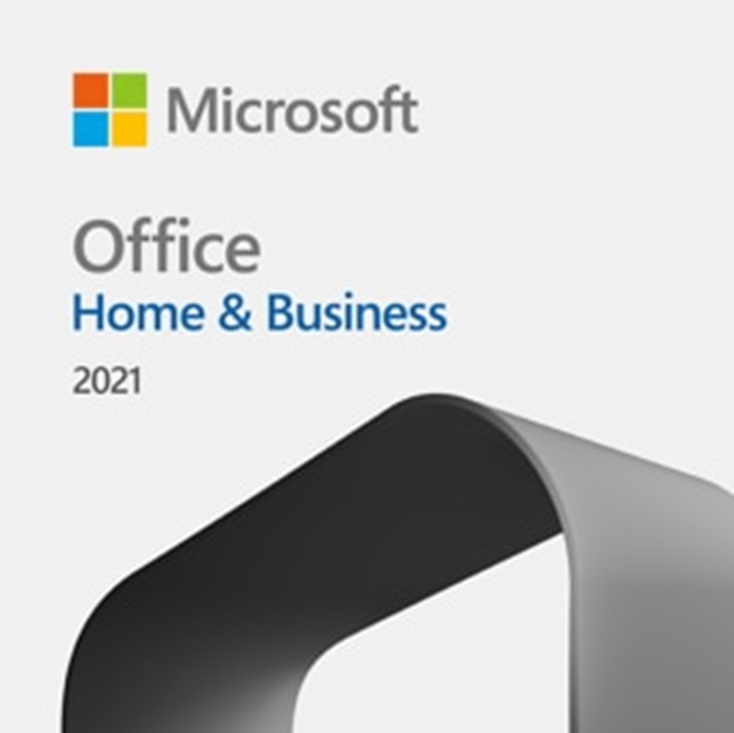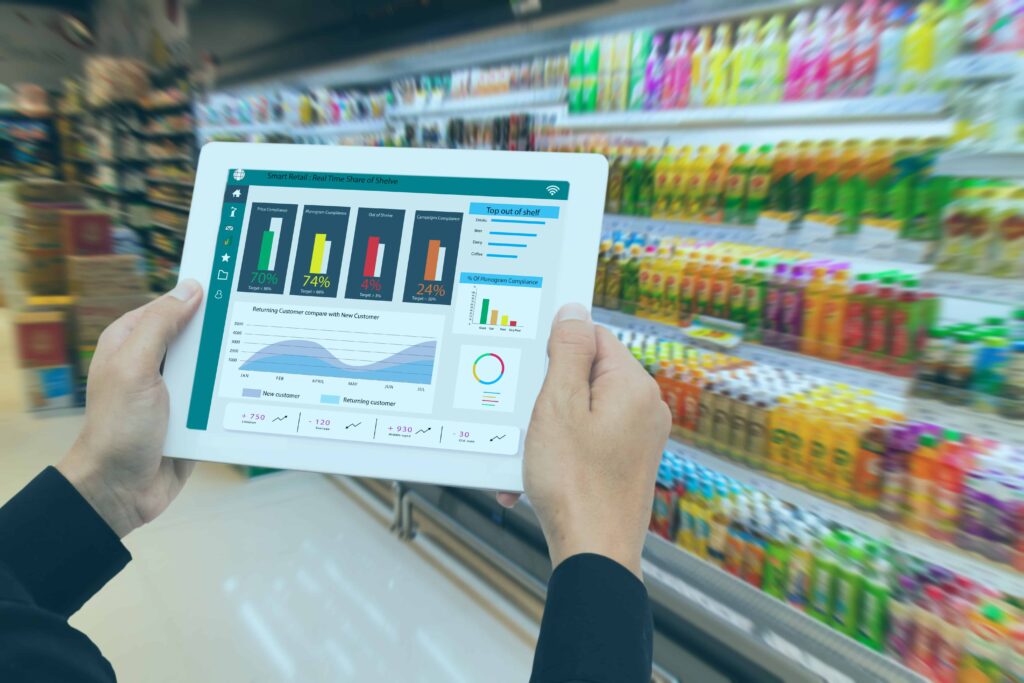
Did you know that the retail industry is undergoing a groundbreaking transformation fueled by the power of the Internet of Things (IoT)? According to a report by Grand View Research, the global IoT in the retail market is projected to reach a staggering $94.4 billion by 2025, with a compound annual growth rate (CAGR) of 21.5%. These numbers are a testament to the growing influence of IoT in revolutionizing retail experiences and shaping the future of shopping.
As we step into this exciting era of connected devices and innovative technologies, it’s crucial to understand IoT’s immense impact on the retail landscape. From enhancing inventory management to personalizing customer experiences, IoT is reshaping how retailers operate and interact with consumers. So, let’s dive into IoT in retail and explore how it transforms our retail shops.
Table of Contents
What is IoT in Retail
Definition and Concept of IoT in the Retail Industry
To grasp the significance of the Internet of Things (IoT) in retail, it’s crucial to understand its definition and concept within the industry.
IoT in retail refers to the interconnected ecosystem of devices, sensors, and software that collect and exchange data, enabling retailers to make data-driven decisions and deliver enhanced shopping experiences. Integrating physical and digital elements creates a seamless, connected environment where data flows seamlessly across various touchpoints.
At its core, IoT in retail revolves around leveraging technology to gather and analyze data from diverse sources, such as point-of-sale systems, mobile devices, beacons, smart shelves, and wearable devices. This data is then processed and used to optimize operations, personalize marketing efforts, improve customer engagement, and transform the retail experience.
Overview of IoT Technologies and IOT Devices Used in Retail
Sensors and RFID (Radio-Frequency Identification):
These small, smart devices are embedded in products, shelves, and other physical objects. They enable retailers to track and monitor inventory levels, manage stock replenishment, and enhance supply chain efficiency.Beacons:
Bluetooth Low Energy (BLE) beacons are small transmitters that communicate with mobile devices nearby. Beacons enable retailers to deliver location-based marketing messages, personalized offers, and tailored customer recommendations.Smart Shelves:
These shelves are equipped with weight sensors, RFID technology, or computer vision systems to detect product levels, monitor inventory movement, and provide real-time data on stock availability. Smart shelves enable efficient inventory management and reduce out-of-stock situations.Connected Point-of-Sale (POS) Systems:
IoT-enabled POS systems collect transactional data, customer information, and sales analytics. This data can be utilized to understand customer preferences, streamline checkout processes, and facilitate personalized recommendations.Wearables and Mobile Devices:
Smartwatches, fitness trackers, and smartphones with IoT capabilities offer retailers a direct channel to engage with customers. These devices can collect customer behavior, location, and preferences data, allowing retailers to deliver personalized experiences and targeted marketing campaigns.Smart Fitting Rooms and Interactive Displays:
IoT-powered fitting rooms and displays enhance the in-store experience by providing product information, recommendations, and virtual try-on capabilities. These technologies bridge the gap between physical and digital retail, creating immersive and engaging shopping environments. By leveraging these IoT technologies and devices, retailers can gain valuable insights, automate processes, enhance customer experiences, and drive business growth.IoT Applications in the Retail Sector
Enhancing Inventory Management through IoT Solutions
Inventory management is one of the primary areas where IoT significantly impacts the retail sector. By implementing IoT solutions, retailers can gain real-time visibility into their inventory, automate stock monitoring, and optimize replenishment processes.
Here are some key points to explore:
1. IoT-enabled Sensors and RFID:
Retailers can deploy sensors and RFID technology to track inventory levels, monitor product movement, and automate stock replenishment. These technologies provide accurate and up-to-date information on stock availability, reducing the chances of out-of-stock situations and improving overall inventory accuracy.
2. Predictive Analytics:
By combining IoT data with predictive analytics algorithms, retailers can forecast demand patterns, anticipate stock shortages, and optimize inventory levels. This proactive approach helps to ensure that popular products are readily available, minimizing lost sales due to unmet customer demand.
Improving Customer Experiences with IoT-Driven Personalization
IoT enhances customer experiences by enabling personalized interactions and tailored recommendations. By leveraging customer data collected through IoT devices, retailers can create individualized shopping experiences.
Here are some key points to cover:
1. Location-Based Marketing:
IoT technologies such as beacons enable retailers to deliver personalized marketing messages and promotions based on a customer’s location within the store. This targeted approach enhances customer engagement and increases the likelihood of conversion.
2. Personalized Recommendations:
IoT-powered systems, such as smart shelves and connected POS systems, gather customer preferences and purchase history data. Retailers can leverage this data to offer personalized product recommendations, cross-selling opportunities, and relevant offers, creating a more personalized and tailored shopping experience.
3. Smart Fitting Rooms:
IoT-enabled fitting rooms equipped with interactive displays and RFID technology enable customers to receive personalized product recommendations, access additional product information, and try on virtual outfits. This immersive experience enhances customer experience and increases the likelihood of purchasing.
Optimizing Supply Chain and Logistics Using IoT Technologies
IoT technologies offer tremendous potential for optimizing supply chain and logistics operations in the retail business. Retailers can improve efficiency, reduce costs, and enhance visibility by connecting various supply chain elements.
Consider the following points:
1. Real-time Tracking and Tracing:
IoT devices, such as GPS trackers and RFID tags, enable real-time tracking of shipments, providing retailers with accurate information on the status and location of goods. This improves supply chain visibility, minimizes delays, and enables proactive management of potential disruptions.
2. Temperature and Environmental Monitoring:
IoT sensors can be deployed to monitor temperature, humidity, and other environmental conditions while transporting and storing sensitive products such as perishable goods or pharmaceuticals. This ensures product quality and safety, reducing waste and potential losses.
3. Predictive Maintenance:
IoT-driven predictive maintenance helps retailers optimize the performance and lifespan of critical assets, such as delivery vehicles and warehouse equipment. By analyzing data collected from IoT sensors, retailers can identify potential maintenance issues in advance, reducing downtime and improving operational efficiency.
By leveraging IoT technologies in these areas, retailers can streamline operations, enhance customer experience, and gain a competitive edge in the retail business.
Benefits of IoT in Retail
Increased Operational Efficiency and Cost Savings
The adoption of IoT in the retail market brings several benefits that contribute to increased operational efficiency and cost savings.
Here are the key advantages to explore:
1. Process Automation:
IoT devices automate various tasks and processes in retail operations, reducing the need for manual intervention. This automation streamlines operations improves accuracy, and saves time and labor costs.
2. Inventory Optimization:
Real-time inventory monitoring through IoT sensors helps retailers optimize inventory levels. By avoiding overstocking or stockouts, retailers can minimize holding costs, reduce waste, and maximize sales opportunities.
3. Energy Management:
IoT-enabled energy management systems allow retailers to monitor and control energy consumption in their stores. Retailers can achieve significant cost savings and reduce their environmental footprint by optimizing energy usage based on real-time data and predictive analytics.
Enhanced Customer Engagement and Satisfaction
IoT technology enables retailers to deliver personalized and engaging customer experiences, increasing customer engagement and satisfaction.
Consider the following benefits:
1. Personalized Recommendations:
IoT devices gather data on customer preferences and behaviors, enabling retailers to deliver personalized product recommendations and offers. This personalized approach enhances customer experience and drives repeat purchases.
2. Seamless Shopping Experiences:
IoT-powered solutions like smart stores and mobile payment systems enable frictionless and convenient shopping experiences. Customers can easily find products, purchase, and receive personalized assistance, improving overall satisfaction.
3. Enhanced Customer Service:
IoT devices enable retailers to provide real-time customer support through chatbots, virtual assistants, or IoT-enabled customer service kiosks. This immediate and personalized assistance enhances customer experience and resolves queries efficiently.
Data-Driven Decision Making and Predictive Analytics
IoT generates vast amounts of data, and retailers can leverage this data to make informed decisions and gain valuable insights through predictive analytics.
Here are the benefits to highlight:
1. Demand Forecasting:
Retailers can accurately forecast demand patterns by analyzing IoT-generated data, enabling proactive inventory management and better supply chain planning. This reduces stockouts, minimizes excess inventory, and improves overall efficiency.
2. Customer Behavior Analysis:
IoT devices capture data on customer behavior, such as dwell time, browsing patterns, and purchase history. Analyzing this data helps retailers understand customer preferences, optimize store layouts, and tailor marketing strategies to target specific customer segments.
3. Predictive Maintenance:
IoT sensors can monitor the performance and condition of equipment and assets in real-time. By applying predictive analytics to the collected data, retailers can proactively anticipate maintenance needs, schedule repairs, and minimize equipment downtime.
By harnessing the benefits of IoT in retail, businesses can unlock new opportunities for growth, efficiency, and customer satisfaction.
Use Cases of IoT in the Retail Industry
Smart Shelves and Inventory Tracking Systems
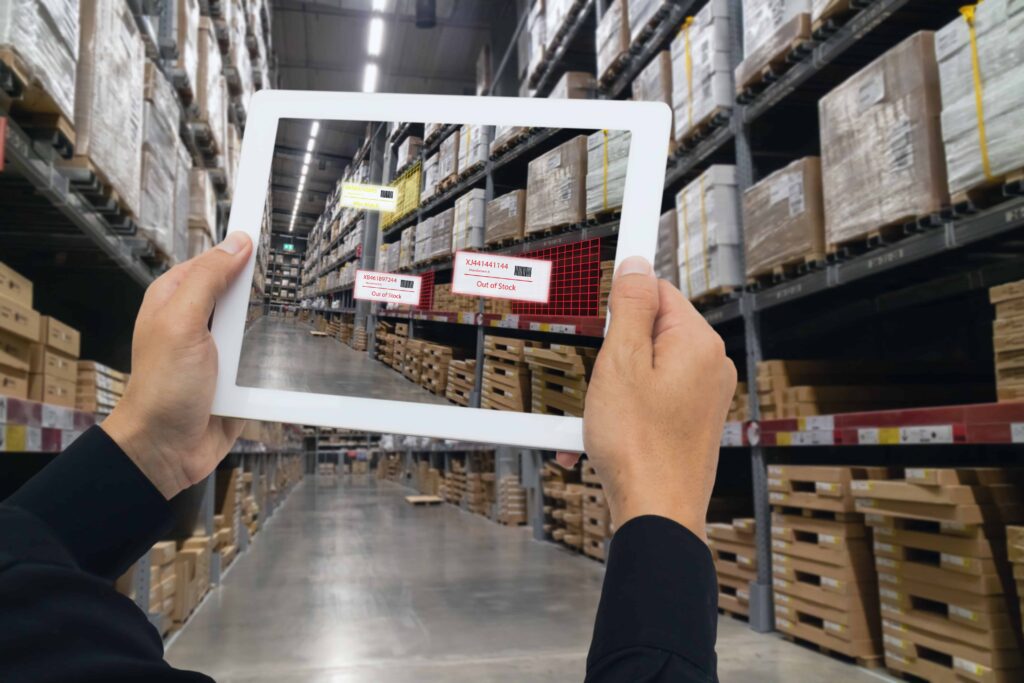
One of the prominent use cases of IoT in the retail industry is the implementation of smart shelves and inventory tracking systems. This technology utilizes IoT sensors and RFID tags to monitor product levels, track inventory movement, and automate replenishment.
The benefits include:
Real-Time Inventory Visibility:
Smart shelves provide real-time visibility into product availability and location, enabling retailers to monitor stock levels accurately. This eliminates manual inventory checks, reduces stockouts, and improves operational efficiency.
Automated Replenishment:
IoT-powered inventory tracking systems can automatically trigger replenishment orders when products reach a specified threshold. This streamlines inventory management, prevents out-of-stock situations, and ensures optimal product availability.
Demand Forecasting and Analytics:
By analyzing data collected from smart shelves and inventory tracking systems, retailers can gain insights into consumer buying patterns, demand trends, and sales performance. This information empowers retailers to make data-driven decisions, optimize stock levels, and improve overall profitability.
Connected Shopping Carts and Smart Payment Solutions
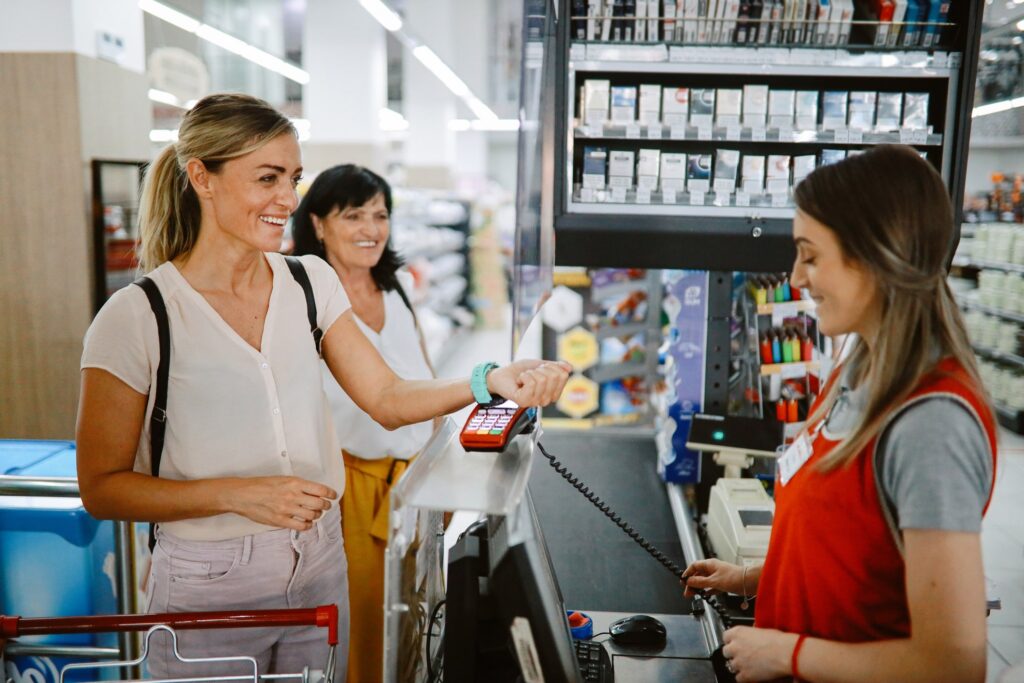
IoT technology has revolutionized the shopping experience through connected shopping carts and smart payment solutions. These innovations offer convenience, efficiency, and a seamless checkout process.
Key benefits include:
1. Enhanced Shopping Experience:
Connected shopping carts equipped with IoT technology can assist customers in navigating the store, locating products, and accessing personalized promotions. This improves customer engagement and satisfaction.
2. Automated Checkout:
IoT-enabled shopping carts can automatically scan products and calculate the total purchase amount. This eliminates manual scanning at the checkout counter, saving time and reducing queues.
3. Contactless Payments:
Smart payment solutions, such as IoT-enabled mobile wallets or RFID-based payment systems, enable secure and contactless transactions. Customers can conveniently complete purchases using smartphones or wearable devices, enhancing safety and convenience.
IoT-Enabled Beacons for Personalized In-Store Experiences
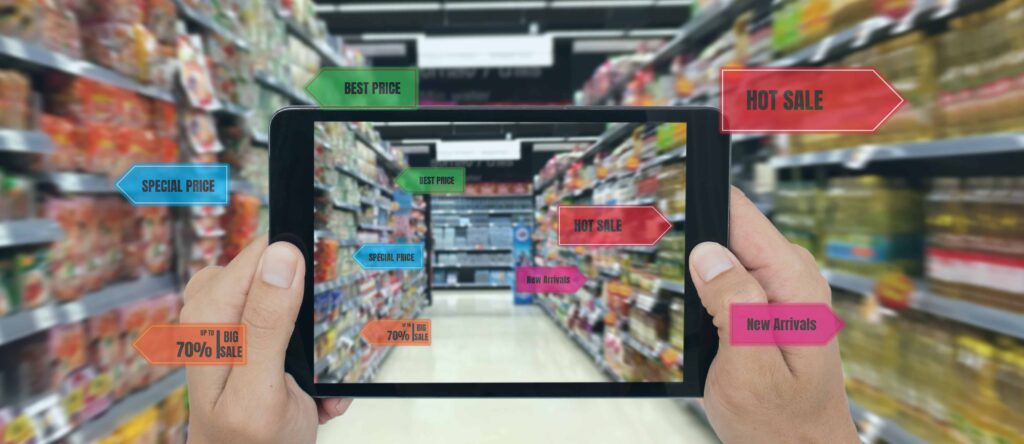
IoT-enabled beacons have transformed the way retailers engage with customers inside their stores. These small wireless devices use Bluetooth to communicate with smartphones, delivering personalized offers, recommendations, and information.
Notable benefits include:
1. Proximity Marketing:
By leveraging IoT beacons, retailers can send targeted promotions, discounts, and personalized recommendations to customers’ smartphones based on their location within the store. This enables hyper-personalized marketing campaigns and increases the likelihood of conversions.
2. Indoor Navigation:
IoT beacons help customers navigate large retail spaces or malls by providing real-time location information and turn-by-turn directions. This improves the overall shopping experience and reduces customer frustration.
3. Data Collection and Analysis:
Beacons collect valuable data on customer behavior, including foot traffic patterns, dwell time, and popular store areas. Retailers can analyze this data to optimize store layouts, product placements, and marketing strategies.
By incorporating these IoT use cases, retailers can create engaging and tailored customer experiences while gaining operational efficiencies and driving revenue growth.
Real-World Examples of IoT Implementation in Retail
Case Study 1: Amazon Go - Reinventing the In-Store Shopping Experience
Amazon, the global e-commerce giant, revolutionized the retail industry with its cashier-less stores known as Amazon Go. By leveraging IoT technologies such as computer vision, sensor fusion, and deep learning algorithms, Amazon Go stores offer a seamless shopping experience to customers. Shoppers can walk in, grab the needed items, and walk out without waiting in line or going through the traditional checkout process.
Case Study 2: Walmart - Streamlining Inventory Management with IoT
The world’s largest retailer, Walmart, has embraced IoT to optimize its inventory management processes. With the help of IoT-enabled sensors and RFID tags, Walmart can monitor stock levels in real-time, track expiration dates, and automatically trigger replenishment orders. This IoT-driven approach has significantly improved efficiency, reduced out-of-stock instances, and ensured fresher products on the shelves.
Case Study 3: Coca-Cola - Smart Vending Machines for Enhanced Customer Interaction
Coca-Cola, a renowned beverage company, has integrated IoT into its vending machines to create interactive and personalized customer experiences. These smart vending machines use IoT sensors and data analytics to offer targeted promotions, customized recommendations, and even enable mobile payments. Through IoT, Coca-Cola has transformed traditional vending machines into intelligent touchpoints that engage consumers in innovative ways.
Case Study 4: Nike Fit - Personalized Shoe Fitting with IoT
Nike Fit is an innovative IoT solution introduced by Nike to help customers find the perfect fit for their shoes. Customers can scan their feet using a smartphone app and computer vision technology to generate precise measurements, including length, width, and arch height.
By leveraging IoT, Nike Fit revolutionizes the shoe fitting process, allowing customers to find the most accurate shoe size and ensuring a comfortable fit. This personalized approach enhances customer satisfaction, reduces returns, and enables Nike to offer tailored recommendations for specific shoe models based on individual foot measurements.
These real-world examples demonstrate IoT’s tangible benefits and transformative impact on the retail industry.
Future Prospects of IoT in the Retail Landscape
Emerging Trends and Advancements in IoT for Retail
In this section, we delve into the emerging trends and advancements that are shaping the future of IoT in retail:
1. Edge Computing:
Adopting edge computing in IoT systems allows faster data processing and analysis, reducing latency and enabling real-time decision-making. This advancement enhances the overall efficiency and responsiveness of IoT solutions in retail.
2. Artificial Intelligence and Machine Learning:
Integration of Artificial Intelligence (AI) and Machine Learning (ML) technologies with IoT in retail enables intelligent automation, predictive analytics, and personalized customer experiences. These technologies empower retailers to gain valuable insights, automate processes, and deliver tailored customer recommendations.
3. Blockchain Technology:
Blockchain’s decentralized and secure nature can revolutionize various aspects of retail, including supply chain management, product authenticity verification, and transparent transactions. It enhances trust, reduces fraud, and provides a more reliable and traceable retail ecosystem.
Anticipated Impact of IoT on the Future of Retail Experiences
The continued integration and expansion of IoT technologies will significantly influence the future of retail experiences.
Here are some anticipated impacts:
1. Hyper-Personalization:
IoT-enabled devices and sensors will enable retailers to gather vast amounts of customer data, enabling hyper-personalized shopping experiences. Customers can expect tailored product recommendations, customized promotions, and personalized assistance throughout their shopping journey.
2. Seamless Integration of Online and Offline Channels:
IoT will bridge the gap between online and offline retail channels, creating a seamless and cohesive shopping experience. Customers will enjoy features such as click-and-collect services, personalized online-to-offline promotions, and in-store digital interactions.
3. Enhanced Connectivity and Smart Environments:
IoT will create smart retail environments where interconnected devices, such as smart shelves, mirrors, and shopping carts, work together to provide a frictionless and immersive shopping experience. Customers can expect real-time product information, personalized offers, and interactive in-store experiences.
4. Data-Driven Decision-Making:
The abundance of data collected through IoT devices will empower retailers to make data-driven decisions. From optimizing inventory management to predicting consumer trends, retailers can leverage IoT-generated insights to drive operational efficiency and stay ahead in a competitive market.
As IoT advances and reshapes the retail landscape, retailers must adapt and embrace these technologies to stay relevant and meet evolving customer expectations.
Conclusion
As retailers navigate the ever-changing industry landscape, it is imperative for retailers to embrace IoT, staying ahead of the curve and meeting customers’ evolving expectations. By harnessing its capabilities, retailers can create a future where shopping becomes more personalized, seamless, and enjoyable.
Embracing IoT is not just a choice but a necessity in delivering exceptional and transformative retail experiences.
Remember, the power of IoT lies in its ability to connect the digital and physical realms, opening up a world of possibilities for retailers and consumers alike.

